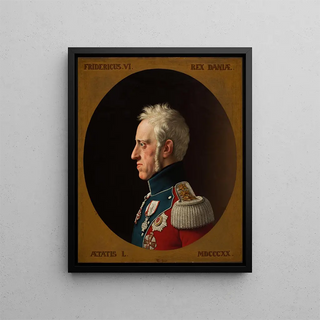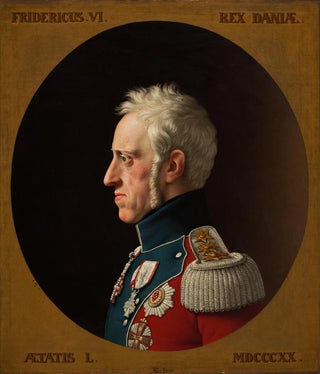Painting Portrait of Frederick 6 - Christoffer Wilhelm Eckersberg


View from behind

Frame (optional)
The "Portrait of Frederick VI" by Christoffer Wilhelm Eckersberg is an iconic artwork that transcends mere representation to offer a glimpse into the soul of a king. Created in the early 19th century, this painting embodies not only power and majesty but also an artistic sensitivity that still resonates today. Through this portrait, Eckersberg does not merely capture Frederick VI's physical appearance but manages to express a deeper essence, a humanity rich in nuances. This painting, as a mirror of its time, invites reflection on the role of royalty and the values that underpin it.
Style and uniqueness of the work
Eckersberg's style is distinguished by its finesse and precision, characteristic of the neoclassical movement. In the "Portrait of Frederick 6," every detail, from the drapery of the robe to facial expressions, is carefully crafted, demonstrating undeniable technical mastery. The colors, both vivid and subtle, create an atmosphere that seems to suspend time. The king is depicted in a majestic posture, but his gaze, full of gravity, reveals an introspection that invites the viewer to ponder the challenges and responsibilities that accompany power. The harmonious composition and skillful use of light emphasize this duality, making the work both accessible and complex.
The artist and his influence
Christoffer Wilhelm Eckersberg, often considered the father of Danish romanticism, knew how to mark his era with an innovative approach to painting. Trained at the Royal Danish Academy of Fine Arts in Copenhagen, he developed a style that combines tradition and modernity. His influence extends beyond Denmark's borders, inspiring many European artists who sought to capture not only external beauty but also inner emotions. Eckersberg managed to integrate elements of realism while preserving a romantic sensitivity, allowing him to create works that speak to the soul. The "Portrait of Frederick 6" is a perfect example of this quest for authenticity and depth,

Matte finish

View from behind

Frame (optional)
The "Portrait of Frederick VI" by Christoffer Wilhelm Eckersberg is an iconic artwork that transcends mere representation to offer a glimpse into the soul of a king. Created in the early 19th century, this painting embodies not only power and majesty but also an artistic sensitivity that still resonates today. Through this portrait, Eckersberg does not merely capture Frederick VI's physical appearance but manages to express a deeper essence, a humanity rich in nuances. This painting, as a mirror of its time, invites reflection on the role of royalty and the values that underpin it.
Style and uniqueness of the work
Eckersberg's style is distinguished by its finesse and precision, characteristic of the neoclassical movement. In the "Portrait of Frederick 6," every detail, from the drapery of the robe to facial expressions, is carefully crafted, demonstrating undeniable technical mastery. The colors, both vivid and subtle, create an atmosphere that seems to suspend time. The king is depicted in a majestic posture, but his gaze, full of gravity, reveals an introspection that invites the viewer to ponder the challenges and responsibilities that accompany power. The harmonious composition and skillful use of light emphasize this duality, making the work both accessible and complex.
The artist and his influence
Christoffer Wilhelm Eckersberg, often considered the father of Danish romanticism, knew how to mark his era with an innovative approach to painting. Trained at the Royal Danish Academy of Fine Arts in Copenhagen, he developed a style that combines tradition and modernity. His influence extends beyond Denmark's borders, inspiring many European artists who sought to capture not only external beauty but also inner emotions. Eckersberg managed to integrate elements of realism while preserving a romantic sensitivity, allowing him to create works that speak to the soul. The "Portrait of Frederick 6" is a perfect example of this quest for authenticity and depth,
12,34 €






